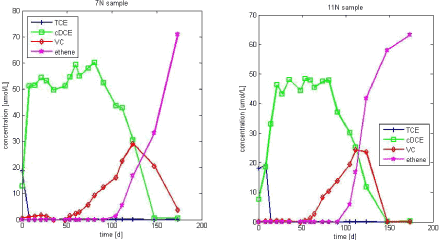Model assessment of reductive dechlorination as a remediation technology for contaminant sources in fractured clay: Modeling tool
Appendix C Results from treatability study experiments
The treatability study aimed to assess the potential for TCE dechlorination at a given field site. In these experiments perspective, groundwater and sediments from the site were mixed with TCE and concentrations of several compounds (TCE and its degradation products, redox compounds, electron donor) were measured under different conditions:
- Unamended conditions
- Addition of electron donor
- Addition of both electron donor and dechlorinating culture
The experimental data used in this study comes from Rugårdsvej field site, where TCE/cis-DCE contamination is present in both sand and clay materials. Hence the treatability study has been performed with both sand and clay sediments in the experimental bottles [Jørgensen et al, 2007b].
Sand sediments are taken from three boreholes in the secondary groundwater magazine (samples K, L and M). Two electron donors are tested, lactate and propionate and the enriched culture KB-1TM is used for bioaugmentation.

Figure C.1 – TCE degradation in experiments with K sediment and lactate as electron donor – note that the time axis scale varies between figures

Figure C.2 – TCE degradation in experiments with K sediment and propionate as electron donor – note that the time axis scale varies between figures
Dechlorination is incomplete under natural conditions and that is necessary to add electron donor to degrade completely TCE completely to ethene. The addition of dechlorinating biomass accelerates the degradation processes.
These results suggest the presence of two bacteria groups, one responsible for the dechlorination to cis-DCE and another (Dehalococcoides), which is able to degrade cis-DCE to ethene. In the natural conditions experiments, the first group degrades TCE to cis-DCE, but in the absence of substrate, the second group cannot grow and no further degradation is observed. In the experiment with electron donor addition, the initial small population of Dehalococcoides grows on the added substrate before being able to degrade cis-DCE and VC. The lag-time between TCE and cis-DCE degradation corresponds to the “growing time” of the second bacteria group. In the 11 and 7 K experiments, cis-DCE degradation occurs as soon as KB-1 culture is introduced (day 57), resulting in a faster dechlorination.
The same experiments have been performed with clay sediments instead of sand from a groundwater aquifer. The clay material comes from three different locations (samples N, O and P) and 5 electron donors have been tested: lactate, propionate, HRC, Chitorem and Newmann zone. KB-1TM culture was added to the samples after 57 days.

Figure C.3 – TCE degradation with N sample (clay) and lactate (left) and propionate (right) as electron donor
As it can be seen on Figure C.3, there is a release of cis-DCE from the clay sediments into the water sample, at the beginning of the experiments. This indicates that sorption processes occur in this system.
The three experiments conditions represent the different remediation strategies that can be applied at a contaminated site:
- Natural attenuation
- Biostimulation with injection of substrate
- Biostimualtion combined with bioaugmentation
The experimental data presented in this section have been used to conceptualize the dechlorination model and determine the kinetics parameters.
Version 1.0 July 2009, © Danish Environmental Protection Agency